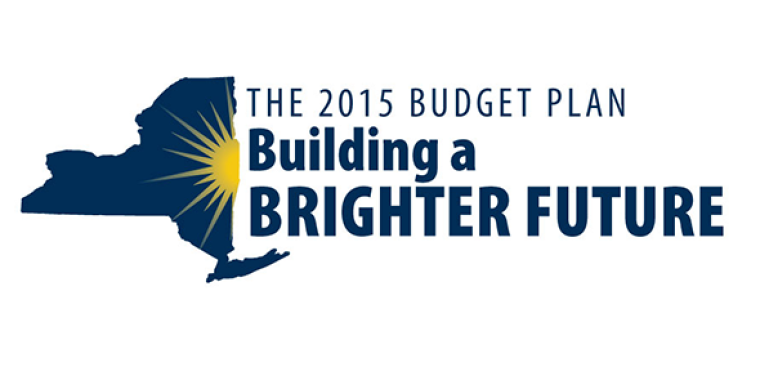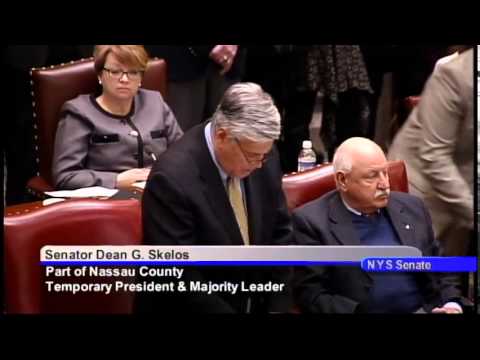
Senate Republicans Propose Budget Cutting Measures
Dean G. Skelos
October 14, 2009

SENATE REPUBLICANS PROPOSE BUDGET CUTTING MEASURES
Senate Republican Leader Dean Skelos today outlined a plan to close
the state’s projected budget deficit resulting from a budget that raised
spending by more than $13 billion and taxes by more than $8 billion.
“Just as I warned last spring, the Democrats’ decision to raise taxes
and spending hurt our economy, caused more pain for taxpayers, and still
left us with an enormous budget deficit,” Senator Skelos said. “Despite
billions in federal stimulus aid, we now find ourselves in a deficit
situation that is largely the result of spending money we don’t have and
taxing people and businesses who can’t afford to pay any more. Our only
course of action is to cut spending.”
At a leaders meeting last month, Senator Skelos was the only one to
propose specific spending reductions to help close the deficit. Today, he
offered new proposals that would result in additional savings.
Specifically he proposed:
> Cutting back the $2.2 billion in general fund spending added to the
2009-10 budget by legislative Democrats;
> Cutting state agency non-personal services by ten percent to save
$480 million;
> Freezing state purchases of recreational lands to save $78 million;
> Freezing planned Medicaid expansions to save $200 million;
> Reinstating welfare and Medicaid anti-fraud protections to save $34
million;
> Cutting Medicaid optional services to save $150 million; and
> Cutting state agency contract balances by five percent to save $300
million.
“In cutting state spending we cannot simply off-load costs to local
governments that would force them to raise property taxes,” Senator Skelos
said. “In addition, we should not take any action that hinders our ability
to create jobs.”
Senator Skelos said he was disappointed that there have been no
proposals by Legislative Democrats to close the deficit that was largely of
their making. “Speaker Silver is still not ruling out tax increases and is
refusing to put any ideas forward to cut spending. As for Senate
Democrats, waiting for their plans is like waiting for a slow boat to
China.”
Senator John A. DeFrancisco, Ranking member of the Senate Finance
Committee said: “If New York City leadership had had open budget
discussions and adopted the proposals in the
2009-10 budget made by the Republican Conference, we wouldn't be in the
deficit situation that now exists. Hopefully, these Republican proposals
will now be part of the solution, and the tough choices that most of our
residents are making will now be made by State leadership to
comprehensively attack the budget deficit."
Senate Republican Recommendations For Cost Cutting and Budget Savings
- Review $2.2 billion in General Fund spending added to the 2009-10 Budget
by the Legislature for possible reductions (table attached).
The SFY 2009-10 budget includes over $2.2 billion in General Fund spending
that was added to Governor Paterson’s Executive budget proposal by the
Democrat majorities in the Senate and Assembly. In other words, more than
$2.2 billion in General Fund spending which was not originally proposed by
Governor Paterson was included in the final adopted budget. All of this
additional spending was discretionary and was not required under the
American Recovery and Reinvestment Act.
Approximately $1.2 billion was used to restore reductions proposed by the
Governor in his Executive budget and approximately $1 billion was used to
finance new spending. All of these spending items should be immediately
reviewed for potential reductions. Freezing all funds for new and increases
to current spending programs alone would save hundreds of millions of
dollars. In addition, the Democrats in both houses rejected many of
Governor Paterson’s proposed legislative changes in the budget that would
have saved over $100 million this year. Lastly Governor Paterson proposed
$700 million in health care savings initiatives that were not included in
the adopted budget which should be revisited.
(See attached file: legaddstoexec09_10.pdf)
- 10% Cut in State Agency Non-Personal Service - $480 million
Efficiency savings of 10% are assumed under this proposal. Selected
categories include: equipment spending; employee travel; lease, maintenance
and repairs; supplies and materials; telephone services; employee benefits
and general state charges and utilities and centralized services. Potential
actions include: Freeze all new vehicle purchases; Freeze all new
equipment/furniture purchases; Suspend all unnecessary travel for State
employees; Limit agency printing to essential services only; Limit agency
mailings/postage expenses to essential services only; Eliminate all agency
non emergency blackberry/cell phone usage; Turn down the heat in state
buildings everyday and not just weekends; Freeze agency spending from state
operation reappropriations; Freeze agency spending for employee training;
Close agency regional offices; Reduce the size of agency public information
offices; Freeze agency spending for conferences; Freeze all pending State
rental agreements- new or renewal - to reduce space; Freeze all State
agency advertising and marketing spending; Freeze all state agency public
information office spending; Eliminate all State agency intern program
spending; Freeze all new technology spending; Freeze equipment leases not
executed; Freeze nonessential building repairs; Freeze all agency
subscription service spending; Freeze agency membership payments for
professional entities; Competitively bid State Employee medical/ hospital/
dental programs.
- Freeze State Purchases of Recreational Land – Savings $78 million
This proposal would freeze the purchase of additional recreational land by
the State. Given the State Fiscal Year (SFY) 09-10 Executive proposal to
renege on the State’s current local tax obligation on existing State owned
lands, the State cannot continue to purchase land. Current cash balances
for this purpose would be transferred from the Environmental Protection
Fund.
- Freeze Planned Medicaid Expansions – $200 million by 2011-12.
All initiatives to expand the State’s Medicaid program should be stopped
immediately as the State cannot afford the current program which is the
most expansive in the nation. The Paterson administration is seeking to
expand eligibility for Family Health Plus (FHP) to 200 percent of the
federal poverty level. FHP enrollment in New York is projected to grow by
another 128,000 families over the next four years. Expansions in
eligibility to the Child Health Plus program should also be reevaluated.
Higher Medicaid enrollment and use will add $975 million to the
state-taxpayers' share of Medicaid costs by 2011-12, according to the
governor's financial plan. Meanwhile, federal stimulus aid is supposed to
expire the year after next, which will leave New Yorkers to cover more than
$3 billion a year now temporarily underwritten by federal stimulus aid.
- Reinstitute Medicaid and Welfare Anti-Fraud / Taxpayer Protections - $34
million
The adopted budget includes an initiative to “streamline access to
coverage”. This “streamlining” of the Medicaid and welfare application
process works by eliminating mechanisms designed to protect the taxpayers
from fraud, waste and abuse such as the requirement for face-to-face
interviews, fingerprinting and asset tests for determining eligibility.
All of these safeguards should remain in place to insure that those
receiving Medicaid and welfare benefits are indeed eligible under the law.
- Cut Medicaid Optional Services - $150 million
The New York State Medicaid program offers nearly 2 dozen optional services
not required under the Federal Medicaid program. Reducing the number of
optional services to those required by the Federal government would reduce
costs. Eliminating all optional services would save the state $150 million.
- Cut 5% from Select Agency Contract Balances - $300 million
As of September of 2009, the undisbursed balance of existing state
contracts totals more than $129 Billion. This proposal excludes the
following types of contracts: authority, revenue generating, repayments to
state contracts, community project fund, construction, construction
related, non general fund, Department of Health, State Ed, and contracts
with zero balance. The proposal assumes a 5% reduction in all undisbursed
balances, of which 1% would be General Fund savings.
#####
Share this Article or Press Release
Newsroom
Go to NewsroomSenate Passes the “Brighter Future” Budget Plan
March 11, 2015

Senator Skelos Invites Nominees for 2015 "Women of Distinction"
February 27, 2015

